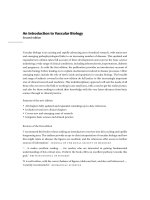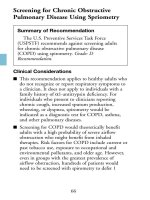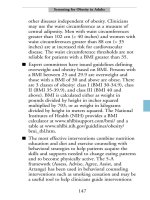A Practical Guide to Clinical Virology Second Edition - part 7 pdf
Bạn đang xem bản rút gọn của tài liệu. Xem và tải ngay bản đầy đủ của tài liệu tại đây (656.75 KB, 29 trang )
itself, HHV-6-induced reactivation of other infectious agents such as CMV, or
some other event for which HHV-6 reactivation is merely a marker is
responsible for the observed disease manifestations. Fever, bone marrow
suppression, hepatitis, pneumonitis, encephalitis, graft or organ rejection, and
an increase in infections from CMV and fungi have been associated with
HHV-6.
THE VIRUS
HHV-6 is the sixth of eight described human herpesviruses. Like the other
members of the group, it has an electron-dense core composed of double-
stranded DNA (160–170 kbp long) surrounded by nucleocapsid in the shape of
an icosahedron. A tegument surrounds the capsid, and a trilaminar membrane
surrounds the entire structure. The nucleocapsid is 90–110 nm in diameter, and
the mature virion ranges from 160 to 200 nm in diameter. The genome of
HHV-6 is most closely related to HHV-7; of all other herpesviruses these two
similar viruses are most closely related to CMV. Two variants of the virus have
been described, HHV-6A and HHV-6B. Although both utilize the ubiquitous
human CD46 as a receptor, there are likely to be other factors involved in
attachment or fusion as the two variants display different cellular tropisms in
tissue culture and in the host. These tropisms may relate to observed disease
associations. HHV-6B causes nearly all HHV-6-associated roseola and has
been implicated in most of the observed complications in immunosupressed
hosts, while HHV-6A has only rarely been implicated in disease. HHV-6B
grows well in mature lymphocytes while HHV-6A replicates better in immature
lymphocytes.
EPIDEMIOLOGY
HHV-6 is a ubiquitous virus which is found worl dwide and appears to infect
most children by the age of two years. The virus can be found in the saliva of
around 70% of asymptomatic adults, closely matching the seroprevalence in
the adult population. Transmission is thought to occur by direct contact with
infectious secretions passing from asymptomatic adults to seronegative
children, typically from mother to child. Virus can be recovered from saliva,
genital secretions and brain at autopsy in asymptomatic adults. Virus is
generally only recovered from blood during viraemia such as at the he ight of
fever during primary infection (roseola) or during reactivation in immuno-
compromised hosts, but can be detected in latent form with sensitive
techniques such as PCR.
THERAPY AND PROPHYLAXIS
There is no specific antiviral therapy for roseola. Supportive care such as
hospitalization of infants for dehydration is sometimes necessary. Ganciclovir
170
has antiviral activity in vitro, and it has been suggested that severe illness
associated with reactivation in immunosuppressed hosts be treated with
ganciclovir or foscarnet. Clinical efficacy data are not available.
Prophylaxis is not available.
LABORATORY DIAGNOSIS
Diagnosis of roseola is clinical. HHV-6 can be detected by culture of peripheral
blood mononuclear cells during primary infection or reactivation but is rarely
used due to its difficulty. Laboratory diagnosis in immunosup pressed patients
by seroconversion or qualitative PCR is available commercially but is rarely
helpful clinically due to the high rate of seropositivity (approaching 100% at
age 2 years) and frequency of positive PCR in sites such as blood, saliva and
brain tissue. Quantitative and real-time PCR techniques are currently found
only in research laboratories and may pro ve more useful for delineating disease
associations by following serial values from blood.
171
PREVENTING TRAVEL SICKNESS?
A Practical Guide to Clinical Virology. Edited by L. R. Haaheim, J. R. Pattison and R. J. Whitley
Copyright
2002 John Wiley & Sons, Ltd.
ISBNs: 0-470-84429-9 (HB); 0-471-95097-1 (PB)
24. HEPATITIS A VIRUS
Hepatitis A has been called infectious hepatitis, epidemic hepatitis
and short incubation hepatitis.
M. Degre
´
Hepatitis A is a viral infection resulting in an acute ne croinflammatory disease
of the liver. The clinical features are age-dependent, mostly mild or sub-clinical
in children, while in adults dominated by jaundice and general fatigue.
TRANSMISSION/INCUBATION PERIOD/CLINICAL FEATURES
Virus is excreted in the faeces mostly during the late phase of incubation
period and to a lesser extent during the early phase of the disease. It is
transmitted via the faecal–oral route, through contaminated water and
food and direct contact, especially under poor hygienic conditions. The
incubation period is approximately 4 weeks (2–6 weeks) and dependent
on the size of inoculum.
SYMPTOMS AND SIGNS
Prodromal phase: Malaise, Weakness, Mild Fever, Nausea and
Vomiting, Anorexia, Headache, Abdominal
Discomfort
Icteric phase: Jaundice, Itching, Dark Urine, Pale Stools
The majority of young patients are symptomless or they have mild
general symptoms. The prodromal phase that lasts 2–7 days is followed
by the icteric phase lasting usually 1–2 weeks, often longer in adults.
Some patients show general fatig ue for several weeks, or e ven months.
Extrahepatic manifestations are uncommon.
COMPLICATIONS
Fulminant hepatitis occurs in less than 1% of patients. Relapsing
hepatitis A and cholestatic forms have been de scribed but are also
uncommon.
173
THERAPY AND PROPHYLAXIS
There is no specific causal therapy available. Normal immunoglobulin
has a protective effect when given before or shortly after exposure. Both
inactivated and attenuated vaccines have been developed and are
available.
LABORATORY DIAGNOSIS
The clinical virological diagnosis is made by demonstrating the presence
of IgM antibodies in the early phase of clinical disease or by demon-
strating seroconversion. Early infection can be diagnosed by the presence
of IgG antibodies.
174
Figure 24.1 HEPATITIS A VIRUS (ACUTE HEPATITIS A)
CLINICAL FEATURES
SYMPTOMS AND SIGNS
The incubation period is usually 4 weeks (2–6 weeks). The site of the primary
infection is in the alimentary tract, although the sequence of events that begins
with entry via the gastrointestinal tract and eventually results in hepatitis is not
well understood. A short prodromal or preicteric phase, varying from 2 to 7
days, usually precedes the onset of jaundice. The most prominent symptoms in
this phase are fever, headache, muscular and abdominal pain, anorexia,
nausea, vomiting and sometimes arthralgia. Hepatomegaly and leukopenia are
often present during this period. In typical cases the urine becomes dark, and
the stools pale before appearance of yellow discoloration of the mucous
membranes and appearance of jaundice about 10 days after onset of the
general symptoms. Fever and most of the general symptoms usually subside
within a few days of jaundice, but in severe cases both general and abdominal
symptoms may become further aggravated at this phase. Jaundice is often
accompanied by itching and sometimes by urticarial or papular rashes. Liver is
usually enlarged and liver function tests are abnormal with highly elevated
levels of serum alanine aminotransaminase (ALT) and serum aspartate
aminotransaminase (AST).
Differential diagnosis. It is not possible to differentiate between hepatitis A and
acute hepatitis caused by other infectious agents, e.g. hepatitis B, hepatitis C,
hepatitis E, cytomegalovirus and EBV, by clini cal examination or by liver
biopsy. The history and epidemiological details are of great importance in
reaching a presumptive diagnosis. The precise aetiology must be confirmed by
laboratory tests.
CLINICAL COURSE
Most infections run an asymptomatic course, especially in children. The disease
is usually mild and of short duration in children and young adults. Clinical
symptoms are likely to disappear after 10–14 days. In adults the symptoms are
often more severe and long-lasting, e.g. 4–5 weeks. The liver function tests
rapidly return to normal when clinical symptoms disappear, but in some cases
symptoms may persist for several months, during which time the patient feels
tired and often depressed. Hepatitis A virus does not cause chronic hepatitis,
although long-lasting excretion of virus has been reported.
COMPLICATIONS
Fulminant hepatitis with a clinical picture of acute yellow atrophy is an
uncommon but serious (lethality 0.3%) complication with high mortality.
Extrahepatic complications like myocarditis and arthritis are also rare.
175
THE VIRUS
Hepatitis A virus (HAV) is a member of the picornavirus family. It consists of
a naked icosahedral particle of 27 nm diameter. The genome is a single-
stranded RNA, linear, positive-sense, 7.48 kbp, MW 2.25 million daltons. It
codes for a polyprotein, which is cleaved into four major structural proteins
VP1–4. The surface proteins VP1–3 are major an tibody-binding sites. It was
first provisionally classified as enterovirus 72, but subsequently it has been
shown that both nucleotide and aminoacid sequences are dissimilar from the
other enteroviruses, and it is now classified as its own genus, hepatovirus.
Although minor strain variations occur, there is only one serological type, but
we can differentiate between four geno-
types. Hepatitis A virus is stable to
treatment with organic solvents, ether and
acid and is more heat-resistant than other
picornaviruses; it withstands 60 8C for 1
hour. The virus is difficult to adopt to cell
cultures and replicates very slowly, usually
without cytopathogenic effect. In vivo HAV
primarily multiplies in Peyer’s patches in
the intestinal tract and later in hepatocytes
and Kupffer cells. Viral antigen can be
demonstrated by immunofluorescence in
liver biopsies. The liver damage is prob ably
partly a direct result of the viral cyto-
pathogenic effect, but T-cell-mediated
immunological mechanisms seem to be
important. HAV can be transmitted to
chimpanzees and marmoset monkeys.
EPIDEMIOLOGY
Hepatitis A has been known since the time of Hippocrates and has a worldwide
distribution. The epidemiology of the disease is a function of its principal route
of spread, faecal –oral transmission. Water- and food-borne epidemics are well
documented. Man is the only significant reservoir, and infection provides
lifelong immunity. Three major patterns of infection are known which reflect
different epidemiological situations. These are demonstrated by different
patterns of the age-specific prevalence of antibodies to HAV which reflect
standards of hygiene and sanitation, the degree of crowding of the population
and opportunities for the virus to survive and spread. In developing countries
hepatitis A is endemic, and more than 90% of the adult population is immune.
In industrialized countries most people are susceptible to infection and
travellers to developing countries thus carry the risk of contracting the
infection. The occurrence of hepatitis A in north-west European countries and
in North America has been much reduced during the last decades. Antibodies
176
Figure 24.2 HEPATITIS A
VIRUS DECORATED WITH
ANTIBODY. Bar, 100 nm
(Electron micrograph courtesy
of E. Kjeldsberg)
to HAV have been found in 80–90% of individuals born before World War II,
but only 5–20%, or even less, of those under 20 years of age.
THERAPY AND PROPHYLAXIS
There is no specific therapy. Bed rest is traditional in the treatment of hepatitis
A and is recommended if the general situation indicates so, especially in elderly
patients and during pregnancy. The preventive effect of immunoglobulin is well
documented. Administration of 0.02–0.06 ml/kg (2–5 ml) nor mal immuno-
globulin before exposure gives 80–90% protection for a period of 4–6 months.
Even after infection, given during the early part of the incubation period,
immunoglobulin can prevent clinical disease, although virus may be present in
the intestines. Immunoglobulin is recommended to people travelling to
endemic areas. A formalin-inactivated vaccine is now general ly available.
After two doses of vaccine almost 100% of individuals develop antibodies and
are protected against infection. An attenuated vaccine has also been
introduced. Spread of virus infection is to a large extent a function of
socioeconomic standards and can be prevented by means of good hygiene.
Infectivity of virus is destroyed by boiling for 15 minutes or at 60 8C for 30
minutes. Chlorine derivatives, formaldehyde and glutaraldehyde are all
effective in routinely employed concentrations, while phenols, ether and
other organic solvents are not. Isolation of the patients is not necessary as
infectivity in the icteric phase is usually insignificant.
LABORATORY DIAGNOSIS
HAV is present in stools before the onset of clinical symptoms and can be
demonstrated by electron microscopy. Isolation in cell cultures is difficult and
not practical for diagnostic use. Detection of nucleic acid with PCR can be
useful both as an epidemiologic al tool and in environmental studies but it is
not indicated for clinical use. Antibodies can be demonstrated from the onset
of the clinical symptoms. Diagnosis of acute infection requires demonstration
of anti-HIV IgM antibodies or seroconversion. IgM antibodies disappear
about 3–6 months after the onset of disease. IgG antibodies on the other hand
persist for life and indicate immunity against reinfection. Antibodies are
demonstrated by means of EIA or RIA.
177
RISKY BUSINESS
A Practical Guide to Clinical Virology. Edited by L. R. Haaheim, J. R. Pattison and R. J. Whitley
Copyright
2002 John Wiley & Sons, Ltd.
ISBNs: 0-470-84429-9 (HB); 0-471-95097-1 (PB)
25. HEPATITIS B VIRUS
Previously called serum hepatitis, post-trans fusion hepatitis
and inoculation hepatitis.
G. L. Davis
Infection with the hepatitis B virus (HBV) can result in acute hepatitis,
fulminant hepatitis, a chron ic asymptomatic carrier state, chronic hepatitis,
cirrhosis or hepatocellular carcinoma.
TRANSMISSION/INCUBATION PERIOD/CLINICAL FEATURES
HBV is present in blood and bodily secretions. The virus is most
commonly spread by sexual contact, but it can also be spread from mother
to child at birth, through contaminated needles and transfusion (extremely
rare). The incubation period averages 75 days (range 1–6 months).
SYMPTOMS AND SIGNS
Systemic: Fever, Fatigue, Malaise, Dyspepsia, Rash,
Arthralgia
Local: Hepatomegaly, Pale Stools, Dark Urine, Jaundice
Acute infection is usually mild and anicteric; only about a third of
patients are aware of the infection. Complete recovery occurs in more
than 95% of adults, but is unusual (510%) if infection occ urs in infancy
when most infections become chronic. Chronic HBV infection may
present in one of two ways. Individuals infected early in life are toleran t
of the virus and often have an asymptomatic carrier state with normal
liver tests. Those infected later in life usuall y present with chronic
hepatitis and elevated liver enzymes. The latter are more likely to have
symptoms and develop progressive liver damage at a faster rate.
COMPLICATIONS
About one in six patients with acute hepatitis has serum sickness-like
symptoms of rash, fever and arthralgia. Fulminant hepatitis is unusual
(assumed to be 1 in 200). Chronic hepatitis leads to cirrhosis in more
than 20% of cases, and the risk of hepatocellular carcinoma is increased
about 50-fold. Polyarteritis nodosa, glomerulonephritis and papular
179
acrodermatitis (only in children) occur rarely in those with chronic
hepatitis.
THERAPY AND PROPHYLAXIS
Acute infection can be prevented by the HBV vaccine. Infants born to
HBV-infected mothers should also receive HBV immunoglobulin
(HBIG), which is also recommended for postexposure pro phylaxis.
Interferon eliminates viral replication in 40–50% of treated patients
mostly. Response is usually permanent. Lamivudine and some new
nucleoside analogues may be equally effective, though viral resistance
may emerge.
LABORATORY DIAGNOSIS
In an acute infection the detection of HBsAg and IgM antibody to the
nucleocapsid (HBc) is characteristic, followed by development of
convalescent anti-HBs antibodies. Chronic infection is indicated by the
presence of HBsAg and absence of IgM anti-HBc. Viral replication
occurs during the initial high replicative phase of infec tion and these
patients are HBeAg and HBV-DNA (by a non-PCR method) positive.
About 10% of patients annually will spontaneously develop into a low
replication stage; becoming HBeAg and HBV-DNA (by a non-PCR
method) negative and anti-HBe positive. Loss of HBsAg is extremely
unusual in patients with chronic infection unless they have been treated
with interferon.
180
Figure 25.1 HEPATITIS B VIRUS (ACUTE HEPATITIS B)
CLINICAL FEATURES
SYMPTOMS AND SIGNS
The incubation period of HBV infection averages 75 days (1–6 months). Most
patients have minimal or no symptoms during infection. However, 15%
present with fever, arthralgia and rash, and another 15–20% present with non-
specific symptoms of malaise, anorexi a and nausea. About a quarter of patients
will become icteric. Findings on physical examination are usually non-specific
though hepatomegaly may be noted in some cases.
Differential diagnosis. The symptoms of acute hepatitis are non-specific. Similar
symptoms may be seen in other forms of viral or drug-induced hepatitis. In
children and adolescents, EBV should be considered. In older adults,
cholecystitis, cholangitis and common bile duct obstruction become considera-
tions. The hepatocellular pattern of liver test abnormalities (elevated AST and
ALT with slight or no elevation of alkaline phosphatase) should lead to a
diagnosis rather than biliary disease in most cases. An ALT level higher than
1000 U/litre is seen only in viral hepatitis, drug-induced hepatitis and ischaemic
hepatic injury. Serological diagnosis is required to confirm the HBV infection.
CLINICAL COURSE
Serological markers of infection (HBsAg) appear in the blood early in the
incubation period. This is followed within a few weeks by evidence of viral
replication (HBeAg and HBV-DNA (by a non-PCR method)). These markers
and liver enzymes reach their highest level at about the time of onset of
symptoms, which abate within 2–3 weeks but may persist for months. In the
majority of patients (490%), HBsAg disappears from the blood as the liver
enzymes normalize. Convalescent antibody (anti-HBs) will develop in most of
these patients. Persistence of HBsAg and HBeAg for more than 10 weeks
indicates that chronic infection is likely to evolve. Chronic hepatitis persists for
years. The initial phase is characterized by high levels of viral replication with
detectable HBeAg and HBV-DNA (by a non-PCR method). Patients are
infectious and at risk for progressive live r injury during this period. Cirrhosis
develops in 20–50% of cases. About 10% of patients each year will have a
spontaneous reduction in viral replication in which HBeAg and HBV-DNA
(by a non-PCR method) become undetectable. These individuals are
commonly no longer infectious and their liver disease becomes inactive.
However, it is very unusual for patients with chronic HBV infection to clear the
infection and lose HBsAg unless they receive antiviral treatment.
COMPLICATIONS
The major long-term risks of chronic HBV infection are cirrhosis with hepatic
failure and hepatocellular carcinoma. Cirrhosis develops in 20–50% of cases
181
and is associated with a poor prognosis, particularly if HBeAg is present.
Between 25 and 50% of cirrhotic patients will develop liver failure.
Hepatocellular carcinoma occurs most frequent ly in cirrhotic patients who
have had long-standing liver disease. The risk is increased 450-fold compared
with the normal population. Extrahepatic manifestation of infection such as
polyarteritis nodosa and glomerulonephritis are rare, but when present are
often more problematic than the hepatitis. An increasingly common problem is
the development of viral variants. The most common is the precore mutant
which presents with active replication (HBV-DNA (by a non-PCR method)
positive) but no HBeAg. The patients behave like others with chronic hepatitis,
but their course may be somewhat more aggressive.
THE VIRUS
HBV is a member of the Hepadnaviridae family (Figure 25.2). It is the only
DNA virus among the agents which commonly cause viral hepatitis. The viral
particle (cal led the Dane particle) is 42 nm in
diameter. The lipoprotein (HBsAg) which
encoats the virus is seen not only as a viral
envelope but also by electron microscopy as
free non-infectious tubular and spherical
structures. These forms of HBsAg circulate
in considerable excess compared with the
virion and may play a permissive role in viral
persistence. However, HBsAg may be present
in blood when replication cannot be docu-
mented. Therefor e, the presence of HBsAG
does not necessarily imply contagiousness.
HBV replicates in hepatocytes and possibly
in peripheral blood mon onuclear cells. Its
genome is the smallest of all known animal
DNA viruses. The replicative process is
unusual in several aspects; it has an efficient
genomic design of four overlapping open reading frames, it utilizes successive
strand synthesis and reverse transcription similar to retroviruses, and it has
both glucocorticoid- and hepatocyte-specific enhancing elements. Viral
replication can be documented by measuring HBeAg (a component of the
core gene product) or HBV-DNA (by a non- PCR method) in serum.
EPIDEMIOLOGY
HBV infection is a formidable immense worldwide problem. More than 200
million people are chronically infected. The prevalence is highly variable in the
Far East, and in Mediterranean and Eastern European countries, whereas in
sub-Saharan Africa the endemic rates are highest, with as many as 20% of the
182
Figure 25.2 HEPATITIS B
VIRUS AND HBsAg PARTI-
CLES. Bar, 100 nm (Electron
micrograph courtesy of E.
Kjeldsberg)
population being infected. In North America and Western Europe the infection
is not common (0.1–0.2%). The major route of infection in high endemic areas
is perinatal. In countries of low endemicity, the major routes of infection are
sexual and shared needles amongst intravenous drug users. The latter group is
notoriously difficult to target by vaccination. However, universal or extensive
vaccination may be the only practical means of achieving a significant
reduction of HBV prevalence.
THERAPY AND PROPHYLAXIS
HBV infection is a preventable disease. Vaccination has been available since the
early 1980s, but compliance has been poor in low endemicity areas and the high
cost has delayed widespread usage in high endemicity areas. Postexposure
prophylaxis with high titre hepatitis B immunoglobulin (HBIG) provides short-
term passive protection but is only about 75% effective. No specific treatment
is required for acute hepatitis B since most individuals will clear the infection
spontaneously. Patients with chronic hepatitis should be evaluated for
treatment with alpha interferon. Overall the likelihood of clearing the infection
with interferon is 40–50%, and for patients with elevated ALT and a low
quantity of HBV-DNA (by a non-PCR method) the response is significant and
usually permanent. Many patients will even lose HBsAg over a period of 4–5
years after responding to interferon. HBV is quite sensitive to several new
nucleoside analogies, but the effect of these drugs is usually transient unless
used for at least 12 months. Drug resistant variants may appear, particularly
after prolonged therapy.
LABORATORY DIAGNOSIS
HBsAg is the most important serological marker for identifying infection. It is
present early in acute infection, disappears with resolution of infection and
persists in chronic infection. IgM anti-HBc is essential for the diagnosis of
acute infection, but is also seen occasionally in very active chronic hepatitis.
Anti-HBc antibodies develop and persi st after all HBV infections. The loss of
HBsAg and development of anti-HBc signals resolution of acute infection.
Anti-HBs also occurs post vaccination, but anti-HBc will not be present in such
cases. Chronic infection is manifested by persistent HBsAg. Markers of viral
replication such as HBeAg and HBV-DNA (non-PCR method) are detect able
during the early high replication phase, but are not detectable during the later
quiescent low replication phase. HBeAg is not a reliable marker of HBV
replication when a precore variant is responsible for the infection. Such cases
will be HBeAg negative, anti-HBe positive, but HBV-DNA (by a non-PCR
method) positive.
183
FINALLY NAMED, SEE?!
A Practical Guide to Clinical Virology. Edited by L. R. Haaheim, J. R. Pattison and R. J. Whitley
Copyright
2002 John Wiley & Sons, Ltd.
ISBNs: 0-470-84429-9 (HB); 0-471-95097-1 (PB)
26. HEPATITIS C VIRUS
G. L. Davis
Infection with the hepatitis C virus (HCV) can result in acute hepatitis, a
chronic asymptomatic carrier state, chronic hepatitis, cirrhosis or hepato-
cellular carcinoma.
TRANSMISSION/INCUBATION PERIOD/CLINICAL FEATURES
HCV is present in blood. Although hepatitis C was the major factor
responsible for the large number of post-transfusion hepatitis cases in the
past, this risk has nearly been eliminated by screening of blood donors.
Today, the major known route of spread of this infection is sharing of
needles among intravenous drug abusers. The incubation time is
approximately 7 weeks.
SYMPTOMS AND SIGNS
Systemic: Malaise, Nausea, Anorexia
Local: Hepatomegaly, Splenomegaly, Cholestasis,
Jaundice
Acute infection is usually mild and anicteric; only about a quarter of
patients are aware of the infection. Complete recovery is unusual; more
than 55–85%, depending upon the age of acquisition, develop chronic
hepatitis with elevated liver tests and an even higher proportion have
persistent viraemia. Chronic HCV infection may present in one of two
ways, either a ‘carrier state’ with normal liver enzyme levels or typical
chronic hepatitis. Persons with HCV infection and normal liver enzymes
are usually asymptomatic, but most have some degree of liver injury seen
on liver biopsy. Patients with chronic hepatitis typically have elevated
liver tests, although these may be only slightly increased. Symptoms are
present in only half of patients. It is probably safe to say that most of the
estimated 175 million persons with this infection are not aware of it.
185
COMPLICATIONS
Chronic hepatitis leads to cirrhosis in more than 20% of cases. The risk
of hepatocellular carcinoma is increased. HCV is the major cause of
essential cryoglobulinaemia. This occurs in about half of cirrhotic
patients and can be associated with rash, purpura, vascul itis, arthralgia
and glomerulonephritis.
THERAPY AND PROPHYLAXIS
There is no vaccine or immunoglobulin to prevent HCV infection. The
only agents with known activity are type I interferons (alpha and beta).
More than half of patients permanently eradicate virus when treated
with pegylated (long-acting) interferon and ribavirin for 6 to 12 months.
The response and required duration of treatment is highly dependent on
viral genotype.
LABORATORY DIAGNOSIS
Serological diagnosis of acute infection can be troublesome. Antibody to
HCV is present in only about two-thirds of patie nts at presentation, so
serial samples may need to be tested in order to confirm the diagnosis.
Chronic infection is diagnosed in patients with elevated liver enzyme
levels and anti-HCV antibodies. Individuals with anti-HCV antibodies
and normal liver enzyme values could be falsely positive. The test can be
confirmed using radioimmunoblot assay (RIBA) or detection of HCV-
RNA by an amplified method such as PCR or TMA test.
186
Figure 26.1 HEPATITIS C VIRUS (CHRONIC HEPATITIS C)
CLINICAL FEATURES
SYMPTOMS AND SIGNS
The incubation period of HCV infection averages 50 days (14 days to several
months). Most patients have minimal or no symptoms during acute infection.
As a result, it is quite unusual for infection to be recognized during this stage.
Findings on physical examination are usually non-specific though hepato-
megaly may be noted in some cases.
Differential diagnosis. As with all forms of acute viral hepatitis, the symptoms
are non-specific. Similar symptoms may be seen in other forms of viral or drug-
induced hepatitis. Careful questioning of the patient will identify risk factors
for HCV infection in about two-thirds of cases. However, since seroconversion
is often delayed, a careful search for other causes of liver disease is important.
Evidence for infection with EBV or HHV-6 should be sought. Particularly in
adults, cholecystitis, cholangitis and common bile duct obstruction should be
considered. The hepatocellular pattern of liver test abnormalities (elevated
AST and ALT with slight or no elevation of alkaline phosphatase) should lead
to a diagnosis of hepatitis rather than biliary disease in most cases. An ALT
level higher than 1000 U/litre is seen only in viral hepatitis, drug-induced
hepatitis and ischaemic hepatic injury.
CLINICAL COURSE
Acute infection resolves in only 10–35% of cases. About 55–80% of patients
will develop chronic hepatitis with persistent elevation of the liver enzymes.
Another 10% will develop persistent viraemia with normal liver tests.
Spontaneous resolution of the infection beyond this stage is extremely
unusual. Chronic hepatitis C is usually minimally symptomatic and only
slowly progressive, usually over two to three decades. Thus, most patients do
not come to medical attention until long after the onset of their infection.
However, the disease will progress slowly in the majority of patients and
cirrhosis develops in about 20% of cases. HCV infection is now the leading
cause of hepatocellular carcinoma in some parts of the world, e.g. Japan. Liver
failure results in about a quarter of cirrhotic patients. Chronic hepatitis C is the
leading indication for liver transplantation in the USA.
COMPLICATIONS
The major long-term risks of chronic HCV infection are cirrhosis with hepatic
failure and hepatocellular carcinoma. Cirrhosis develops in 20% of cases and
has a poor prognosis. About 25% of cirrhotic patients will develop liver failure.
About 1 in every 20–30 infections will die from complications of the liver
187
disease caused by the infection. Hepatocellular carci noma occurs most
frequently in cirrhotic patients who have longstanding liver disease. HCV is
now the most common risk factor for hepatocellular carcinoma in many areas
of the world, including Japan.
Extrahepatic manifestations of infection include mixed essential cryoglobu-
linaemia and glomerulonephritis. Although cryoglobulinaemia is common
(450% of patients with cirrhosis) it is not often symptomatic or progressive.
THE VIRUS
HCV is an RNA virus of the hepacivirus genus of the Flaviviridae and is related
to viruses of the animal Pestivirus genus. The physical characterization of HCV
is preliminary since the viral particle has not been visualized with certainty. It
has a lipid membrane since it is inactivated by chloroform and is probably 30–
45 nm in size. HCV replicates in hepatocytes and possible in peripheral blood
mononuclear cells. Its genome is similar in size and structure to other
flaviviruses. Viral replication can be documented by HCV-RNA RT-PCR.
HCV is extremely heterogeneous and, like many RNA viruses, has a high
mutation rate. These genotypes are responsible for the various manifestations
of the disease worldwide, since they are geographically distributed and have
different epidemiology, natural history and response to antiviral treatment.
EPIDEMIOLOGY
HCV infects approximately 1.5–2% of the world’s population, in particular in
Japan, Africa, the Mediterranean countries and the Middle East. There are 3.5
million infected in the USA, making this the most common form of liver
disease. The prevalence and natural history of the infection varies from country
to cou ntry depending on the routes of infection and the common viral
genotypes. The major route of infection was previously blood transfusion.
Before screening of donors, the risk of post-transfusion hepatitis was 10–30%
of recipients. The risk with extensive screening of donors today is about 0.03%
per unit. The major genotypes with transfusion-acquired infection are 1a and
1b. The major routes of infection now are shared needles among intravenous
drug abusers, exposure among health care workers, and perhaps also sexual. In
about 15–30% of cases a risk factor cannot be identified. In the USA and
Europe the genotypes 2 and 3 are more common among drug abusers than in
the general population.
THERAPY AND PROPHYLAXIS
HCV infection can only be prevented by avoiding contact with the virus. There
is no vaccine and the heterogeneity of the virus makes it difficult to develop a
conventional vaccine in the near future. Pre- and postexposure prophylaxis
with immunoglobulin is ineffective. Interferon (alpha or beta) is the only
188
treatment known with activity against HCV. Interferon treatment reduces the
chronicity rate in acute infection. Unfortunately most patients are asympto-
matic during this phase and therefore do not come to medical attention. The
current standard of care for chronic hepatitis C infection is pegylated
interferon in combination with oral ribavirin. A 12 month course of this
drug combination is effective in permanently eradicating infection in about
55% of cases. Viral genotypes 2 and 3 respond better and 80% clear infection
with just 6 months of treatment.
LABORATORY DIAGNOSIS
Anti-HCV is the most important serological marker for identifying infection. It
may not be detectable early in acute infection, but will develop in later serum
samples. Anti-HCV is almost always present during chronic infection. In the
presence of elevated liver tests, anti-HCV is highly specific and need not be
confirmed by immunoblotting or HCV-RNA testing. However, in patients
with normal liver enzymes, anti-HCV should be confirmed by one of these
techniques. HCV-RNA determinations are usually not helpful for diagnosis
other than in carriers with normal liver tests. They may be used, though, in
following the response to treatment and modifying therapeutic regimens. Viral
genotyping is currently of limited value in the clinic. It is possible that future
treatment will be modified according to viral genotype, HCV-RNA levels and
the degree of hepatic injury.
189
. . . OBSERVED LEAVING IN DISGUISE . . .
A Practical Guide to Clinical Virology. Edited by L. R. Haaheim, J. R. Pattison and R. J. Whitley
Copyright
2002 John Wiley & Sons, Ltd.
ISBNs: 0-470-84429-9 (HB); 0-471-95097-1 (PB)
27. HEPATITIS D VIRUS
Previously known as delta agent or delta virus.
G. L. Davis
The delta agent, now designated hepatitis D virus (HDV), multiples only in
persons harbouring hepatitis B virus, after co-inf ection or HDV superinfection.
TRANSMISSION/INCUBATION PERIOD
HDV infection occurs only in HBV-infected patients. Not surprisingly, the
epidemiology of HDV is quite similar to HBV. Most infected patients have
acquired the infection sexually or parenterally by sharing of needles. Infection
can occur concurrently with acquisition of HBV (co-infection) or subsequent to
HBV infection in a patient with chronic hepatitis B (superinfection). Because of
its dependence upon the presence of hepatitis B infection, the incubation period
has not been precisely defined.
THE VIRUS
HDV is a unique virus which consists of a single-stranded circular RNA and
the delta antigen (HDAg) encoated by the lipoprotein coat of the hepatitis B
virus (HBsAg). Hepatitis D virus particles are 35–37 nm in diameter.
CLINICAL FEATURES AND COURSE/COMPLICATION
Co-infection of HDV and HBV is usually self-limited. Since chronic infection
of HBV would be required to perpetuate HDV, chronic HDV infection results
in only about 2% of acute cases. The severity of co-infection varies, but in most
cases is not different from acu te hepatitis B. Co-infection should be suspected
when the acute hepatitis is severe, when a bimodal peak of raised liver enzyme
levels occurs, or in the presence of fulminant hepatitis.
Superinfection with HDV occurs in patients with chronic HBV infection,
usually resulting in chronic HDV with delta antigen persisting in the liver.
Superinfection should be suspected when previously stable chronic hepatitis B
suddenly worsens. Diagnosis is easier than in acute co-infection since both IgM
and IgG anti-HDV quickly become detectable in serum.
191
THERAPY AND PROPHYLAXIS
Treatment options for chronic hepatitis D are limited. Although a-inferferon is
beneficial, it requires high doses for long periods of time and relapse is common
when the therapy is stopped. Hepatitis B vaccine and passive immuno-
prophylaxis prevent HBV infection and thereby avert acute co-infection with
HDV. However, other than avoiding risk-associated behaviour, there is no
specific prophylaxis to avoid superinfection.
LABORATORY DIAGNOSIS
Direct confirmation of HDV infection is made by demonstrating HDAg or
HDV-RNA in serum or liver, but these are generally research tools and not
widely available. Delta antigen may be detected in blood during the first weeks
of infection, and later antibodies against this antigen can be demonstrated by
RIA or ELISA . The presence of delta antigen in the blood may be associated
with a depression of the levels of HBsAg, and even disappearance of HBsAg
for a short period is seen in chronic HBV carriers. Anti-HDV tests are available
and are reliable for diagnosing chronic HDV infection.
Serological diagnosis of acute co-infection is difficult. HBsAg and IgM anti-
HBc will be present as they are in acute infection with HBV alone. However,
anti-HDV antibodies are often delayed or may not be detected.
192
WATER-BORNE AND UNBORN
A Practical Guide to Clinical Virology. Edited by L. R. Haaheim, J. R. Pattison and R. J. Whitley
Copyright
2002 John Wiley & Sons, Ltd.
ISBNs: 0-470-84429-9 (HB); 0-471-95097-1 (PB)
28. HEPATITIS E VIRUS
Hepatitis E virus is a newly identified agent causing epidemic hepatitis,
especially in the developing countries. It has also been called enterically
transmitted non-A, non-B hepatitis.
M. Degre
´
Hepatitis E is a viral infection resulting in a self-limited, enterically
transmitted acute necroinflammatory disease of the liver. The disease
occurs most frequently in epidemic outbreaks, predominantly in young
adults. The clinical features are similar to those caused by hepatitis A, except
for a high mort ality rate that is observed among women in the third trimester
of pregnancy.
TRANSMISSION/INCUBATION PERIOD/CLINICAL FEATURES
The virus is present in the stools before the outbreak and during the early
phase of the disease. It is mostly transmitted by the faecal–oral route,
most likely predominantly by way of contaminated drinking water. The
incubation period is approximately 40 days (15–60 days).
SYMPTOMS AND SIGNS
Systemic: Fever, Malaise, Anorex ia
Local: Jaundice, Abdominal Discomfort, Dark Urine,
Pale Stools
Preicteric prodromal symptoms may be present for a few days and
subclinical forms of the disease exist. Fulminant disease with high
fatality rate in pregnant women has been reported in several outbreaks.
Chronic liver disease has not been observed.
COMPLICATIONS
High mortality rate (10–20%) among infected pregnant women,
especially those in their third trimester, has been observed in several
major epidemics. High incidence of disseminated intravascular
coagulation has been noted in associ ation with the disease.
195









